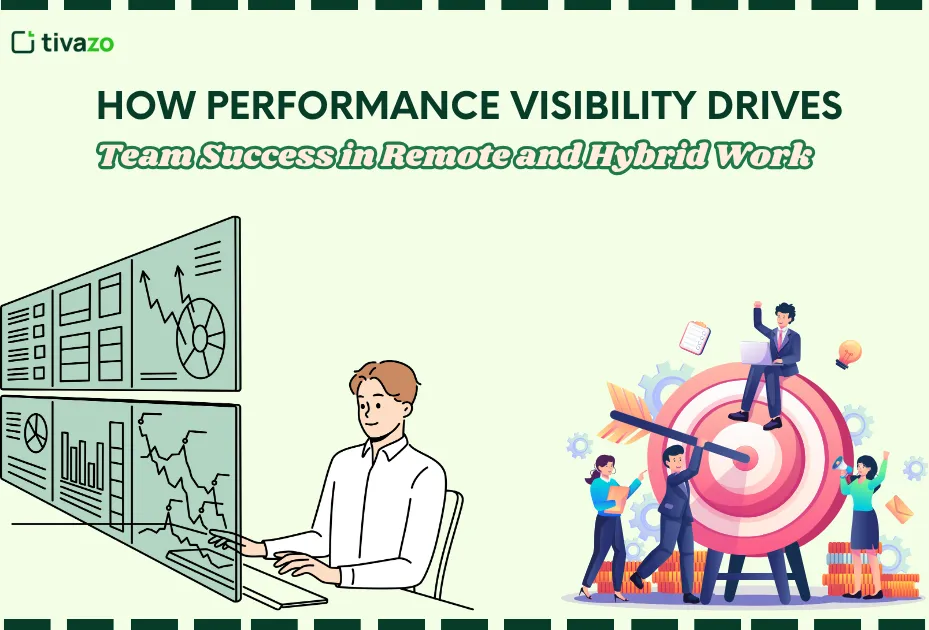Performance visibility practices aim at transforming the work progress, achievement, and or difficulties of the team members publicly across your organization. Imagine that you have a transparent window onto the functioning of your team, their achievements, and the areas they require assistance.
Nowadays, due to a remote and hybrid work environment, employee performance visibility has become more important than ever. In cases where teams are dispersed in various places and time zones, the conventional delivery methods of monitoring improvement are usually not effective. It is impossible to depend on occasional check-ups and body language to know the performance of your team.
Team performance tracking creates accountability while fostering trust. It does not mean to micromanage the day of your employees, but to develop the systems that will enable everyone to know what is expected of the day, acknowledge the victories, and identify the opportunities where change is possible.
The Hidden Challenges of Poor Performance Visibility
Most organizations have what we term as performance blind spots. Here are the parts where the managers cannot have visibility in the real-world productivity and engagement of their team.
Common Problems Teams Face
But when teams lack visibility into remote team performance, the following usually occurs:

- Unclear expectations: Members in a team are not able to discern what constitutes success
- Delayed feedback: The issues are not discovered until they turn out to be significant.
- Uneven workload distribution: Certain members are overworked, whilst some are underworked.
- Missed opportunities: Top performers are not rewarded or offered developmental information
- Communication gaps: A Valuable message fails to get to the right people at the right place and at the right time.
These difficulties are even worsened in a remote environment where one may not freely talk or observe visual communication. The managers lack the means of proactive performance checks; hence, they usually fall back on obsolete methodologies that cause frustration instead of transparency.
How Performance Visibility Transforms Team Dynamics
Effectively planned, open performance management is a win-win situation of action and engagement. Here, organizations that adopt performance visibility usually experience impressive reforms in their culture and outcomes.
Building Trust Through Transparency
Transparency also does not imply divulging all the information about what an employee is doing. Rather, it refers to building collective knowledge of aims, improvements, and results. To the extent that team members are able to find meaning in the implication of their efforts on higher goals, they become more attached to their cause.
The use of performance dashboards as the main point of key understanding in regard to current priorities and progress is made by all. These visual aids bring to life abstract notions of productivity and performance and convert them into sense and action.
Encouraging Continuous Improvement
Having straightforward visibility into performance measures, teams learn to recognize the trends and introduce them into optimization. The software used to track productivity gives information that can inform the team on how to conduct its processes, as well as on resource allocation and skill development.
Teams will be able to adjust in real-time rather than waiting to have these changes reflected during annual reviews. Such an agile solution of performance management keeps all people on the same track and headed in the same direction.
Essential Tools for Effective Performance Visibility

Performance visibility no longer becomes a strenuous experience as it is made possible by the right technology, which renders this experience valuable. The following are the main types of tools applied by successful teams:
Real-Time Performance Dashboards
Contemporary employee productivity layers of knowledge can be attributed to dashboards of main indicators in a form that can be easily understood. These tools demonstrate progress made towards objectives, rate of accomplishment, and staff interactions within a staff without bogging down users with irrelevant data.
Find dashboards that are role and responsibility-based. A project manager wants a different view of a project than a team member, and a good tool will support both of these views.
Goal Tracking and Progress Visibility
The visibility tools of goal progress assist businesses in keeping themselves focused on what is important and not just on what matters. The platforms enable managers and staff to communicate their goals and mark milestones as well as celebrate success throughout the process.
The most efficient goal-tracking tools should not create a need to input data but should be incorporated into the daily workflow. When the progress updates occur automatically in the course and the usual working practice, the system remains up-to-date and in line with the latest changes.
Communication and Collaboration Insights
The tools used to manage teams in a hybrid business environment, which present an overview of communication patterns, allow for detecting the problems that may influence performance before they can do it. Such tools can be used to indicate when the team members feel disengaged or when the critical discussions are not taking place.
Strategies for Improving Performance Visibility Without Micromanaging
The successful performance visibility revolves around the ability to concentrate on the results instead of actions. The following are the strategies for executing employee performance visibility without micromanaging:
Focus on Results, Not Hours
Data-driven management of a team implies quantifying what is truly important in your business. Get out of measuring the amount of time an individual has worked and consider quantifying the kindness and effect of his/her inputs.
Clearly identify what will be delivered and when, and provide individuals on the team with the freedom to deliver the results in whatever way they see fit. This strategy fosters credence whilst being self-accountable.
Regular Check-ins and Feedback
Plan regular individual meetings whose purpose is to talk about the progress, issues, and support requirements. Such discussions ought to be supportive as opposed to appraisal.
With the help of performance reporting software, be ready to discuss these meetings with specific information concerning the results and points of improvement. The presence of data also makes discussions objective and fruitful.
Celebrate Wins and Learn from Setbacks
The real-time performance measures can enable you to see accomplishments on the fly instead of having to wait until your formal appraisal session. Viable behaviors are rewarded instantaneously, and the enthusiasm is elated.
Instead of laying the blame in case of an irresolvable situation with performance data in hand, one can surmise the underlying causes. This philosophy makes losses lessons.
The Benefits of Transparent Performance Tracking for Teams

Organizations that implement effective performance visibility systems see measurable improvements across multiple areas:
Enhanced Productivity and Efficiency
Analytics in terms of workforce performance provides patterns that enable teams to streamline their operations. When there is visibility on where resources such as time and energy are focused, it will be easy to get rid of any inefficiency and concentrate on activities that will have a great impact.
It is common to get engagement in the right performance visibility to report a 25-30 percent improvement in productivity within a period of 6 months of implementation.
Improved Employee Engagement
The issues of performance visibility and employee involvement in remote working are heavily coordinated. By doing this, employees are motivated and identified with their role when employees realise the part they play in achieving team success.
Open performance monitoring also assists workers in owning their professional growth. They are able to view their progression over a period and make informed choices in regards to the development of skills and career objectives.
Better Decision Making
Having visibility of its performance and decision-making based on data helps the managers to make an informed decision regarding how to use its resources, priorities in the project, and how to develop its teams.
Leaders do not have to make decisions relying on guts or half-baked data, but they can use tangible performance data to make decisions.
Increased Accountability
Visibility encourages ownership. When everyone can see progress, team members are more likely to stay responsible and meet expectations without micromanagement.
Better Goal Alignment
Transparent tracking helps align individual tasks with team goals. It keeps everyone focused, reduces confusion, and supports agile decision-making, 0especially in remote setups.
Overcoming Implementation Challenges

Some planning and slow phases of implementation are necessary to fix the challenges of performance visibility in distributed teams.
Starting Small and Scaling Up
Start performing simple performance tracking in one team or project, and then roll out to the whole organization. This practice will enable you to improve your procedures and be able to fix concerns before they become a problem.
Training and Communication
Make sure that team members become aware of the meaning and advantages of performance visibility tools. Once individuals realize that such systems are there to make them prosper instead of keeping track of their actions, the process of adoption is a lot less stressful.
Train in the understanding of how to read performances and utilize the results to improve. The monitoring tools of employee activity are useful to the extent that people understand what to do with the information they provide.
Privacy and Trust Considerations
Be clear on the kind of information you are taking and how it shall be utilized. Design transparent data access policies and make sure that the collected data on performance is applied in constructive and not punitive ways.
Choosing the Right Performance Visibility Solution
In 2025, the most effective tools to see the team performance must merge into your current workflows in an easy way and give you actionable information rather than raw statistics.
Key Features to Look For
Real-time performance visibility: The following are some of the features to look for in the productivity software:
- Role customizable dashboards
- External fitting with current tools and processes
- Mobile accessibility for remote team members
- Programmed reportage and warning features
- Such user user-friendly interface which promotes uptake
Scalability and Flexibility
Select the solutions that can evolve with your team and address the shifting requirements. Performance visibility tools should be effective when applied to either small groups or large organizations.
Building a Culture of Performance Excellence
The performance visibility of a hybrid work culture is not the reason why it is important to individual productivity. It is instilling a company culture that allows everyone to perform their tasks to the best of their abilities and make a positive contribution towards common objectives.
The visibility of performance works when it is integrated into multiple cultures that embrace growth-oriented interaction and continuous improvement. Performance information becomes supportive and empowering to other members when it makes others feel safe and targets positive performance improvement instead of making others feel judged.
Moving Forward with Performance Visibility
Effective performance visibility must be imperative, as leadership and team members have to buy in. Begin by communicating well on expected outcomes and advantages, select the right tools that best suit your team, and be ready to improvise depending on the feedback and results.
The investment in good performance visibility systems is worthwhile both in terms of productivity, employee morale, and the results of the business. In the modern-day competitive environment, clear performance management teams have a great advantage over others that use dated tracking systems.
Performance visibility is not about spying on your team members by observing them at the workplace; performance visibility is concerned with making your team members succeed. When applied in a sensible fashion, such systems establish certain clarity, accountability, and opportunity for all participants.
Are you prepared to change the performance of your team? To begin, find out what your blind spots are today and see what tools you can use to get the visibility you require to make a meaningful change. The performance potential of your team is out there to be released by improved visibility.




